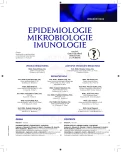Opposite trends in the incidence of gonorrhea and syphilis in the East Bohemian Region – 30 years of surveillance
Authors:
M. Salavec 1; V. Boštíková 2
; P. Prášil 3; J. Smetana 2
; M. Špliňo 2; R. Chlíbek 2
; M. Louda 4; R. Sleha 2,5; V. Štěpánová 6; P. Boštík 2
Authors‘ workplace:
Klinika nemocí kožních a pohlavních, Fakultní nemocnice a LF UK, Hradec Králové
1; Fakulta vojenského zdravotnictví, Univerzita obrany, Hradec Králové
2; Klinika infekčních nemocí, Fakultní nemocnice a LF UK, Hradec Králové
3; Urologická klinika, Fakultní nemocnice a LF UK, Hradec Králové
4; Univerzita Pardubice a oddělení epidemiologie, Univerzita obrany, Hradec Králové
5; Ústav klinické mikrobiologie, Fakultní nemocnice a LF UK, Hradec Králové
6
Published in:
Epidemiol. Mikrobiol. Imunol. 63, 2014, č. 3, s. 213-219
Category:
Review articles, original papers, case report
Overview
The epidemiology of selected sexually transmitted diseases in the Czech Republic has been carefully evaluated for many years. Data from 1981-2011 for eastern Bohemia shows a sharp decrease in the incidence of gonorrhea in 1993-1994 and a very low incidence thereafter with a slightly higher prevalence in males. However, syphilis and genitourinary infections with Chlamydia trachomatis show entirely opposite trends. Also, for the similar number of diagnostic tests performed, Chlamydia had a 10 fold higher rate of positive results. This underscores the changing epidemiology of sexually transmitted infections (STI) and necessity for adapting the reporting algorithms accordingly.
Keywords:
gonorrhoea – syphilis – Chlamydia trachomatis – prevalence – incidence – Czech Republic
Sources
1. Moran J. Gonorrhoea. Clinical evidence, 2005;(13):2016–2023.
2. Bischoff A. Trends in sexually transmitted diseases. Chlamydia and gonococci are often searched for in the wrong place. MMW Fortschr Med, 2011; 153(20):18.
3. Adderley-Kelly B, Stephens EM. Chlamydia: A major health threat to adolescents and young adults. The ABNF journal : official journal of the Association of Black Nursing Faculty in Higher Education, Inc, 2005; 16(3):52–55.
4. Olshen E, Shrier LA. Diagnostic tests for chlamydial and gonorrheal infections. Semin Pediatr Infect Dis, 2005;16(3):192–198.
5. Bennett NJ, Domachowske J. Gonorrhea. In: Steele RW, ed. 2012.
6. Alary M. Gonorrhea: Epidemiology and Control Strategies. The Canadian Journal of Human Sexuality, 1997,V. 6, N. 2.
7. Jakopanec I, Borgen K, Aavitsland P. The epidemiology of gonorrhoea in Norway, 1993–2007: past victories, future challenges. BMC Infectious diseases, 2009:9–33.
8. James AB, Geisler WM. Predictors of high chlamydia and gonorrhoea positivity rates among men in the southern United States. J Natl Med Assoc, 2012, 104(1–2):20–27.
9. van Duynhoven YT. The epidemiology of neisseria gonorrheae in Europe. Microbes Infect, 1999;1(6): 455–464.
10. Tucker JD, Xiang-Sheng Ch, Peeling RW. Syphilis and Social Upheaval in China. N Engl J Med, 2010;362(18):1658–1661.
11. Savage EJ, Hughes G, Ison G, Lowndes CM. Syfilis and ghonorhoea in men who have sex with men: A European Overview. Eurosurveillance, 2009;14(47), article 8. Available from:http://www.eurosurveillance.org/ViewArticle.aspx?ArticleId=19417.
12. Uusküla A, Puur A, Toompere K, DeHovitz J. Trends in the epidemiology of bacterial sexually transmitted infections in Eastern Europe 1995–2005; review. Available from:http://ganymedes.lib.unideb.hu:8080/udpeer/bitstream/2437.2/8277/1/PEER_stage2_10.1136252Fsti.2009.037044.pdf
13. Gogl S, Sarcletti M, Jöchl M, Rieger A, Geit M, Haas B, Taylor, Kanatschnig M, Zangerle R. Ongoing syphilis epidemic among HIV-infected men who have sex with men in Austria. Austrian AHIVCOS Cohort study. Available from: http://abstracts.soedak2009.com/inhalte/SOEDAK_09_P311.pdf
14. Alary M. Gonorrhea: epidemiology and control strategies. In: Canadian Journal of Human Sexuality: SIECCAN; 1997.
15. Aral SO, Holmes KK. Social and behavioral determinants of the epidemiology of STDs: Industrialized and developing countries. In: Holmes KK, Sparling PF, Mardh P-A, et al., eds. Sexually transmitted diseases. 3 ed: McGraw-Hill Professional 1998:39–76.
16. Zakoucká H. Gonorrhoea: Stručné připomenutí aktuálního problému. Zprávy EM (SZÚ, Praha), 2009;18(12): 371–374.
17. Barbosa MJ, Moherdaui F, Pinto VM, Ribeiro D, Cleuton M, Miranda AE. Prevalence of Neisseria gonorrhoeae and Chlamydia trachomatis infection in men attending STD clinics in Brazil. Revista da Sociedade Brasileira de Medicina Tropical, 2010;43(5): 500–503.
18. van Veen MG, Koedijk FD, van der Sande MA. STD coinfections in The Netherlands: Specific sexual networks at highest risk. Sex Transm Dis, 2010;37(7): 416–422.
19. Cook RL, Hutchison SL, Ostergaard L, Braithwaite RS, Ness RB. Systematic review: noninvasive testing for Chlamydia trachomatis and Neisseria gonorrhoeae. Ann Intern Med, 2005;142(11):914–925.
20. Resl V, Salavec M, Kumpová M. Sexual risk behaviors, Nine decades of positive experience with venereal prevention, follow-up and epidemiological tracing in Czechoslovakia abd the Czech Republic respectively. In: L. P, C. S, eds. Sexual risk behaviors: Nova Science Publishers 2010;95–110.
Labels
Hygiene and epidemiology Medical virology Clinical microbiologyArticle was published in
Epidemiology, Microbiology, Immunology

2014 Issue 3
Most read in this issue
- The current view of the diagnosis and management of amebiasis in the light of the authors’ own case reports
- Infections caused by human alpha herpes viruses
- Enterohemorrhagic Escherichia coli as the cause of diarrhea in the Czech Republic, 1965–2013
- Occurrence and characteristic of Staphylococcus aureus in pork meat
